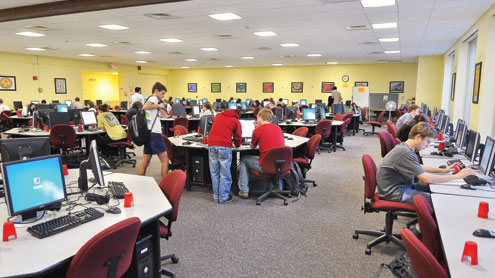In the fall of 2001, the University created the Math Technology Learning Center to teach all introductory level math courses. This year, the MTLC will celebrate its 10th anniversary.
The Department of Mathematics will host two receptions in the Learning Center next week, on Monday from 11 a.m. to 1 p.m. and on Tuesday from 3:30 to 5 p.m., in which UA administrators, academic advisors and the department’s undergraduate advisors can experience the MTLC and speak with the students who use it.
The MTLC was established with a $200,000 grant from the Pew Foundation’s Learning and Technology Program at the Center for Academic Transformation as an effort to modify UA’s intermediate algebra course, Math 100.
The MTLC, which hosts courses in beginning algebra, intermediate algebra, pre-calculus algebra, pre-calculus trigonometry, trigonometry and beginning calculus, aims to teach students math through technological methods.
Students take their courses on a computer from a source that can be accessed online, as opposed to in a traditional classroom. A range of tutors that include graduate teaching assistants, math instructors and undergraduate engineering and math majors are available to assist students when needed.
Robert Olin, dean of the College of Arts and Sciences, believes the methods used in the MTLC are a noteworthy alternative to those of a standard classroom. The MTLC was modeled after the Math Emporium Dean Olin established at Virginia Tech in 1997.
“In the Learning Center, students can learn at their own pace, receive instant feedback on their work, and get individual attention from a tutor whenever they need assistance,” Olin said. “It promises to remove some of the most common stumbling blocks to early success in math, such as not being able to keep up with the class, not receiving adequate feedback and rehearsals while learning math concepts and lack of individual assistance.”
Lance Ross, a graduate teaching assistant in the Learning Center studying geometric group theory, observed that many students may have trouble adjusting to the concept of taking math courses online.
“Some really like it at first because they can work ahead and some don’t like it,” Ross said. “I think the majority [of students] clash at first and then accept it. What the student brings to it is a large part of whether or not they succeed.”
Sam Evers, an instructor in the MLTC, feels that the lab is convenient, not only for students, but for teachers as well.
“Unfortunately, in a traditional paper and pencil setting, an instructor can’t grade everything,” Evers said. “The computer allows us to assign gradable things. There’s some resistance [by students] at first, but it doesn’t take them long to see that [the MTLC] is a pretty good way to learn.”
Despite the need for students to adjust to its environment, the Learning Center has yielded successful results. Since the MTLC’s inception, the rate of students who pass their introductory math classes, although fluctuant, has proved to be significant overall.
“In the fall of 1999, when Math 100 was taught the traditional way, only 40.4 percent of students passed,” Olin said. “Math 100 began in the MTLC in 2000. In fall 2000, that percentage jumped by 10 percent, to 50.2. By fall 2003, 78.9 percent of students were succeeding. Those early numbers indicated to us that the MTLC style of learning works.”









